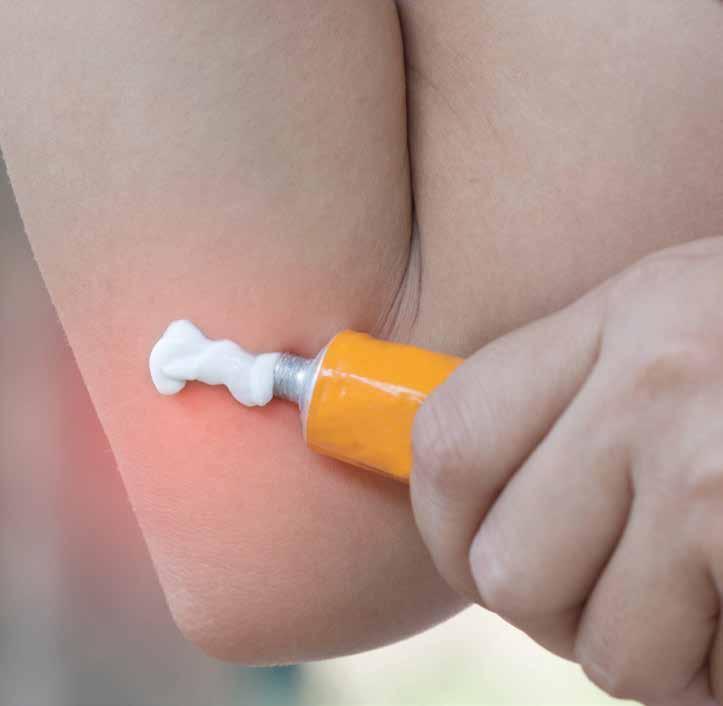TARGETED PAIN RELIEF
73
TARGETED PAIN RELIEF When patients experience muscle and joint pain, pharmacists can recommend topical analgesics (rubs, creams and sprays) to help provide relief for their symptoms. Helping customers choose the right topical analgesic for their individual needs is key if they are to gain optimum benefit. Musculoskeletal pain is likely to affect a significant percentage of the population and encompasses a huge range of conditions. Low back pain, for example, is acknowledged to be the leading cause of disability worldwide and osteoarthritis is purported to affect 60% of 60-year-olds.” While musculoskeletal conditions and the pain, stiffness and immobility that go with them can compromise the lives of sufferers in many obvious physical ways, mental health and wellbeing is also affected. Patients will often use OTC topical analgesics for the treatment and management of musculoskeletal injuries and disorders. These products may have local analgesic, anaesthetic, antipruritic, and/or counterirritant effects. Topical analgesics for musculoskeletal pain can be used alone or in conjunction with oral analgesics when appropriate and warranted. External analgesic products may contain one or more of the following ingredients: methyl salicylate, camphor, menthol, methyl nicotinate, capsicum, and trolamine salicylate.
ASSISTING SELECTION Patient confusion regarding the wide array of topical products and formats available can also hinder usage. Consumers want help and reassurance when it comes to self-treating. They do not understand the difference between various types of topical – hot, cold and non-steroidal anti-inflammatory drugs – or how to use them. Following the introduction of the codeine regulations, pharmacists now encourage the use of acetaminophen as first in line choice of pain relief, followed by ibuprofen, before codeine-based analgesics. In addition, patients must be made aware of how to use the medication properly and must be informed by pharmacists of the possible side effects that can occur when a product is used after the recommended period of three days. Products may have local analgesic, anaesthetic, antipruritic, and/or counterirritant effects. Topical pain killers, or analgesics, are sprayed on or rubbed into the skin over painful muscles or joints. Although all are designed to relieve pain, different products are made up different
ingredients. Counterirritants are approved for the topical treatment of minor aches and pains of muscles and joints. They are often employed for the treatment of acute musculoskeletal injuries and as an adjunct therapy in the treatment of chronic musculoskeletal disorders. Counterirritants differ from other external analgesics in that pain relief results more from nerve stimulation than depression. Topical analgesics for musculoskeletal pain can be used alone or in conjunction with oral analgesics when appropriate and warranted. External analgesic products may contain or more of the following ingredients: methyl salicylate, camphor, menthol, methyl nicotinate, capsicum, and trolamine salicylate. Salicylates: These same ingredients that give aspirin its pain-relieving quality are found in some creams. When absorbed into the skin, they may help with pain, particularly in joints close to the skin, such as the fingers, knees, and elbows.
W W H A M
Capsaicin: The main ingredient of hot chilli peppers, capsaicin is also one of the most effective ingredients for topical pain relief. When first applied, capsaicin creams cause a warm tingling or burning sensation. This gets better over time. Users may need to apply these creams for a few days up to a couple of weeks before they will notice relief from pain. Topical analgesic products are available in a variety of formulations, including gels, ointments, creams, lotions, and patches in single-entity or combination formulations. Topical heat therapy patches are also available in various sizes for treating joint and muscle pain and provide eight to 12 hours of continual, portable heat therapy. OTC topical analgesics are intended to be used for mild to-moderate pain for no longer than seven days. The factors that a pharmacist may consider when recommending a topical analgesic include dosage form, cost, ease of use of product, as well as the patient’s medical history, including possible allergies.
Who? Anyone suffering from pain, musculoskeletal problems or fever. What are the symptoms? Dependent on the condition suffered. How long has the patient had the symptoms? Dependent on the condition suffered. Action already taken? Pain relief. Medication? Apply topical products only to intact skin. Areas treated with counterirritants should not be covered with tight bandages or occlusive dressings. Patients on anticoagulation therapy should be advised not to use topical products that contain salicylates, because concomitant use has been associated with prolonged prothrombin time.






















